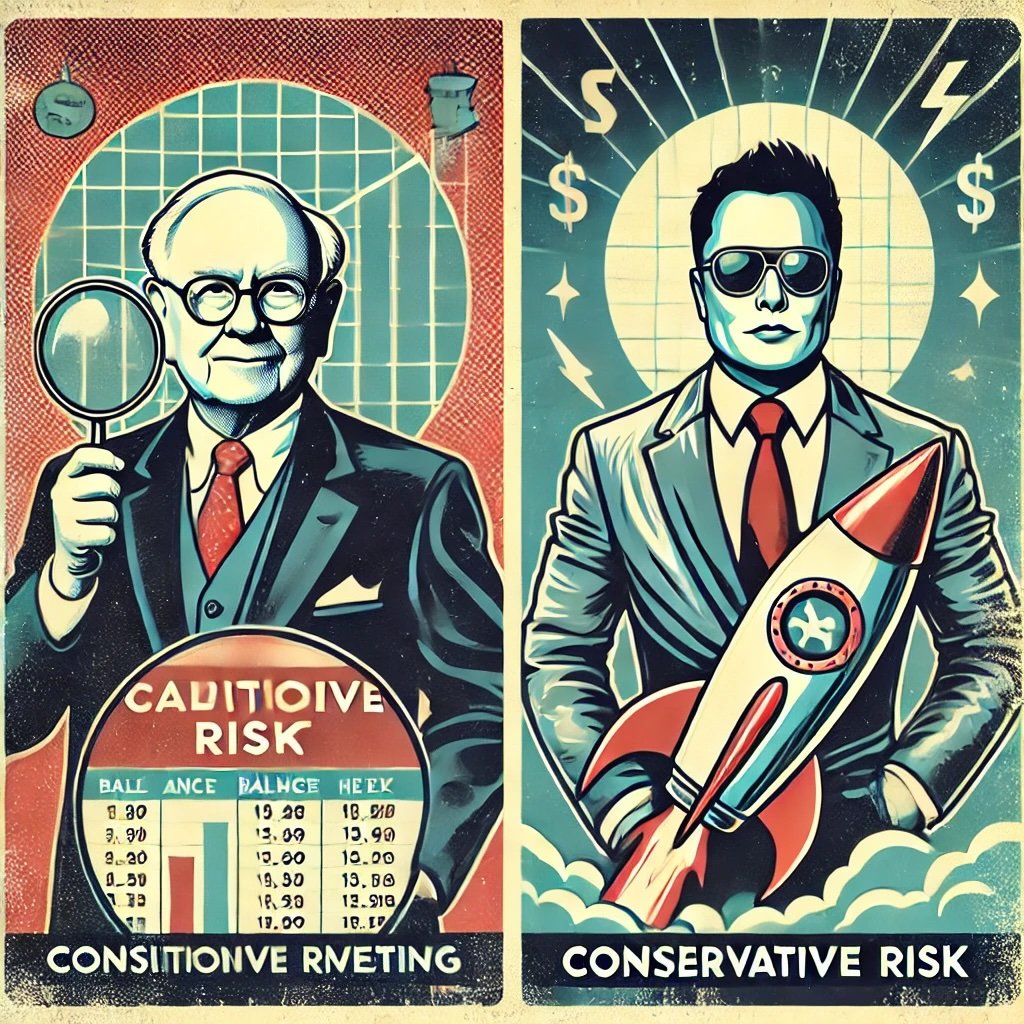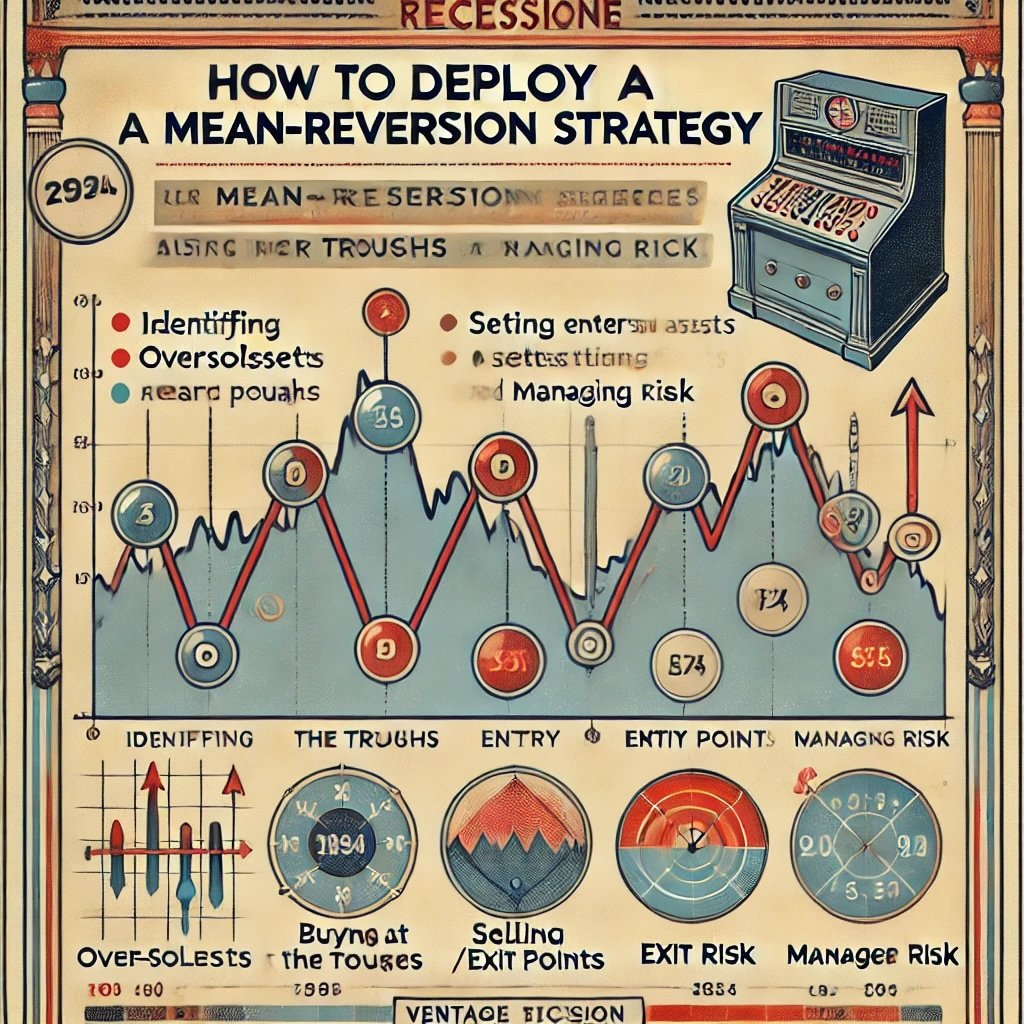Often referred to as the “Oracle of Omaha,” Warren Buffett is a name synonymous with investing wisdom and astute business acumen. Born in Omaha, Nebraska in 1930, Buffett was fascinated by numbers from an early age—a trait that would shape his illustrious career. Today, as the chairman and CEO of Berkshire Hathaway, a multinational conglomerate holding company, he’s celebrated as one of the most successful investors in the world.

His legendary investment strategies, grounded in the principles of value investing and characterized by his propensity for businesses with “economic moats,” have made him a titan in the realm of finance. Yet, despite his tremendous success, Buffett remains remarkably down-to-earth, known for his folksy wisdom, charm, and humility—a sage guiding us through the often turbulent waters of the investment world.

Introduction to the Concept of Economic Moats
The term “economic moat,” derived from the water-filled trenches that surrounded medieval castles to protect them from invaders, is a key concept in Buffett’s investment philosophy. It refers to a business’s ability to maintain a competitive edge, to protect its market share and profitability from rival firms. A company with a wide economic moat has sustainable competitive advantages that shield it, much like those medieval fortresses, from competition and allow it to earn high returns on capital over a prolonged period. These advantages could stem from a variety of sources, such as brand strength, cost advantage, network effect, or regulatory licenses, to name a few.

Economic Moats Deep-Dive
This article is a deep-dive into Warren Buffett’s perspective on economic moats. We’ll explore why he values them so highly, how he identifies them, and how they have influenced some of his most successful investment decisions. Drawing on Buffett’s own words—from shareholder letters, interviews, and public appearances—we’ll aim to understand this integral part of his investment approach and provide readers with actionable insights.
We’ll start by delving into the types of economic moats that Buffett values and how he distinguishes between companies that have true sustainable advantages and those that simply appear to. We’ll also dive into real-life case studies, examining how economic moats have played out in some of Buffett’s most noteworthy investments.
In addition, we’ll tackle the challenges and considerations inherent in identifying and evaluating economic moats. Investing, after all, is not a simple numbers game—it’s a complex discipline that requires a nuanced understanding of businesses and markets.
Finally, we’ll look toward the future, exploring how economic moats might evolve in the face of rapid technological change and what that means for investors. Through it all, we’ll aim to provide a rich, comprehensive understanding of Buffett’s views on economic moats, grounding our exploration in his own words and wisdom. Whether you’re a seasoned investor or just dipping your toes into the investment world, we hope this journey into the mind of one of the world’s greatest investors proves insightful and enriching. Let’s dive in!

Definition of Economic Moats
In the broadest sense, an economic moat is a business’s ability to defend its market position from potential invaders—much like the water-filled moats of yore that protected castles from attacking foes. But unlike the simplicity of those medieval defensive structures, an economic moat is often intricate and multifaceted, woven from the unique strands of a company’s business model, industry position, and strategic decisions.
An economic moat refers to the sustainable competitive advantages that a business possesses—those special qualities that set it apart from rivals and give it a lasting edge. They could stem from a strong brand (think Coca-Cola or Apple), proprietary technology (as with patents held by pharmaceutical companies), network effects (like the ones bolstering Facebook or Uber), cost advantages (enjoyed by large manufacturers with economies of scale), or even regulatory protections (like those surrounding utilities).
But it’s not enough to simply have a competitive advantage; for it to constitute a true economic moat, the advantage must be durable. It must withstand the test of time, not eroding under the relentless tides of market competition and change. In Buffett’s words, “The key to investing is not assessing how much an industry is going to affect society, or how much it will grow, but rather determining the competitive advantage of any given company and, above all, the durability of that advantage.”

The Origins of the Term and Its Relevance in Today’s Business World
The term “economic moat” was coined by Warren Buffett, borrowing imagery from the defensive moats of medieval times. The use of such a vivid metaphor reflects Buffett’s ability to distill complex business principles into clear, relatable terms—a skill that has endeared him to shareholders and the investing public alike.
But while the term may be a product of Buffett’s creative lexicon, the concept it encapsulates is timeless and fundamental to business success. Any company, regardless of its size or industry, strives to carve out a niche for itself where it can thrive and fend off competition. That’s what economic moats represent—the ability to create and sustain a profitable niche despite the ceaseless onslaught of competition.
In today’s business world, where technology and globalization have obliterated many traditional barriers to entry, economic moats are more relevant than ever. They are the bulwarks that protect businesses from a sea of competitors, both old and new, and allow them to thrive. Companies with wide economic moats—think Google with its unrivaled search engine, or Amazon with its unparalleled logistics and distribution network—are able to fend off competition and generate sustained profits.
In essence, the concept of economic moats embodies the intersection of business strategy and investment analysis. For business leaders, it’s about building and maintaining those moats. For investors, like Buffett, it’s about identifying companies with wide, durable moats and investing in them at the right price. Thus, understanding economic moats is not just crucial for investment success; it’s also a lens through which we can understand the competitive dynamics of business and the forces that drive long-term corporate success.
source: Hamish Hodder on YouTube

Importance of Economic Moats According to Warren Buffett
For Warren Buffett, economic moats are not just a strategic curiosity—they are central to his investment philosophy. But why does the Oracle of Omaha place such importance on these competitive barriers?
Simply put, it’s because economic moats signify a company’s ability to generate and maintain above-average profits over the long term, a quality that is inherently attractive to a long-term investor like Buffett. A business with a wide economic moat is often able to stave off competitive threats, protect its market share, and sustain its profitability, factors that contribute to superior long-term investment returns.
Buffett’s appreciation for economic moats also stems from his background in value investing, a school of thought founded by Benjamin Graham, known as the father of value investing and Buffett’s mentor. Value investors look for securities trading for less than their intrinsic values. A company’s intrinsic value is, to a large extent, determined by its future profitability, which is where economic moats come into play. A company with a wide, durable economic moat is likely to remain profitable in the future, thereby having a high intrinsic value.
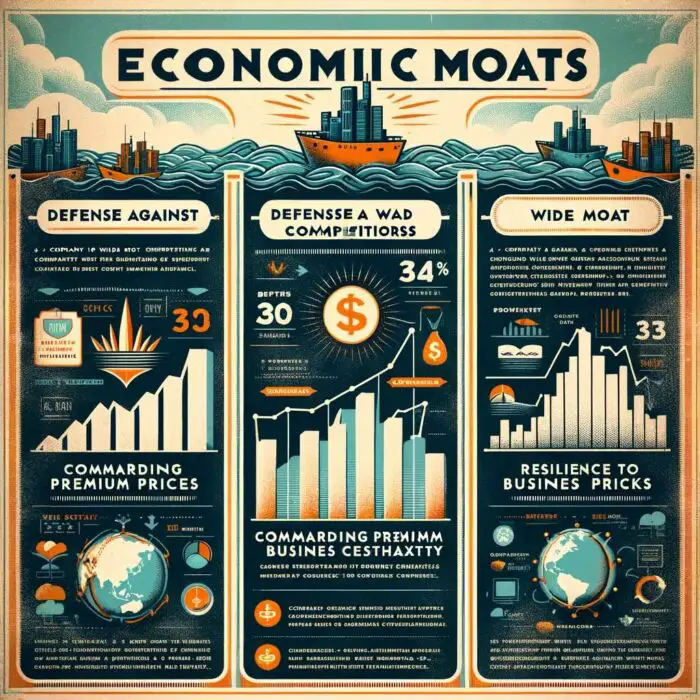
How Economic Moats Contribute to a Company’s Longevity and Profitability
Economic moats, when present and robust, serve as a protective shield for a company, enhancing its longevity and profitability in several ways.
Firstly, they help a company fend off competitors. In any profitable industry, success typically attracts competition. However, a company with a wide moat can defend its turf effectively, preserving its market share.
Secondly, economic moats often allow a company to command premium prices for its products or services. For instance, a company with a strong brand or superior technology can charge more than its competitors, boosting its profit margins.
Finally, a robust economic moat can make a company more resilient to various business shocks. During economic downturns or industry upheavals, companies with strong moats are often better positioned to weather the storm and come out stronger.
Quotes and Insights from Buffett Emphasizing the Importance of Moats
Throughout his career, Buffett has frequently emphasized the importance of economic moats. Here are some quotes that capture his thoughts on the subject:
- In business, I look for economic castles protected by unbreachable moats.” This quote sums up Buffett’s investment approach: he seeks out robust businesses that can defend their territories from encroachments by competitors.
- “The most important thing to me is figuring out how big a moat there is around the business. What I love, of course, is a big castle and a big moat with piranhas and crocodiles.” Here, Buffett underscores the value of a strong, defensible competitive position in business—a metaphorical castle safeguarded by a formidable moat filled with deterrents to competitors.
- “A good business is like a strong castle with a deep moat around it. I want sharks in the moat to keep away those who would encroach on the castle.” Buffett uses vivid imagery to stress the need for strong, preferably insurmountable, competitive barriers to protect a company’s market position and profitability.
In essence, for Buffett, the presence and width of a company’s economic moat significantly influence its investment appeal. This moat-centric approach forms a cornerstone of Buffett’s investment philosophy, guiding his search for durable, profitable investments that stand the test of time.

Types of Economic Moats Buffett Values
Just as no two castles are identical, so too are economic moats unique, each shaped by the specific circumstances and strategic decisions of a company. Broadly speaking, though, economic moats can be categorized into several types: cost advantages, intangible assets, network effects, high switching costs, and efficient scale. Each type represents a different way a company can carve out and defend a profitable niche for itself. Warren Buffett has shown an appreciation for all these types, investing in companies with one or more of these moat sources.
Detailed Analysis of Each Type, Including Examples from Buffett’s Investments
Cost Advantage
A cost advantage exists when a company can produce and deliver its products or services at a lower cost than its competitors. This could be due to superior technology, a more efficient manufacturing process, better procurement, economies of scale, or a variety of other factors. With this cost advantage, a company can price its products competitively while still enjoying healthy margins, often driving higher market share and profitability.
An example from Buffett’s portfolio would be GEICO, the auto insurance giant. GEICO operates a direct-to-consumer model, bypassing agents and brokers, which lowers its operating costs. These savings are then passed on to consumers through lower premiums, giving GEICO a competitive edge in the price-sensitive auto insurance market.
Intangible Assets
Intangible assets like brand strength, patents, regulatory licenses, and trademarks can also provide an economic moat. They can help a company differentiate itself from rivals, command higher prices, and lock in customer loyalty.
Coca-Cola, another iconic Buffett investment, is a prime example of a company with a moat based on intangible assets. Its brand, one of the most recognized in the world, confers upon it a powerful competitive advantage. Consumers worldwide associate Coca-Cola with quality and consistency, allowing it to command premium pricing and enjoy robust customer loyalty.

Network Effect
The network effect occurs when a product or service becomes more valuable as more people use it. Each new user increases the value of the product or service for existing users. Companies that benefit from network effects can often create dominant market positions that are very difficult for competitors to disrupt.
Buffett’s investment in American Express illustrates the power of the network effect. The company operates a closed-loop network, where it serves both cardholders and merchants. As more consumers use Amex cards, more merchants are incentivized to accept them, which in turn attracts more cardholders—a virtuous cycle that strengthens American Express’s competitive position.
High Switching Costs
When it’s difficult or costly for customers to switch to a competitor’s product or service, a company enjoys a moat created by high switching costs. These can stem from contractual obligations, the need for customers to retrain or adapt to a new system, significant data transfer requirements, or other obstacles that make switching unappealing.
A classic Buffett investment demonstrating high switching costs is IBM. Many of IBM’s business customers use complex, integrated software systems that would be costly and disruptive to replace, creating a significant barrier to switching and providing IBM with a steady, recurring revenue stream.

Efficient Scale
Finally, efficient scale refers to a situation where a market is effectively served by one or a small handful of companies. Additional competition could result in losses for all players involved, creating a natural barrier to entry.
BNSF Railway, which Berkshire Hathaway acquired in 2010, is an example of a company operating in a market where efficient scale applies. The rail transport industry requires massive capital investment and has limited capacity for additional players. The regulatory and logistical hurdles to building new railways mean that existing players, like BNSF, can operate with minimal competitive threats.
The types of economic moats that Buffett values are varied and wide-ranging, yet all share a common theme: they are sustainable, defensible advantages that help a company preserve its profitability over the long term. They are protective fortresses that guard against the relentless forces of competition.
Each company in which Buffett invests presents its unique mosaic of competitive strengths, but they all boast at least one broad moat attribute—be it a cost advantage, intangible assets, network effects, high switching costs, or efficient scale. These enduring advantages are the factors that have contributed to Buffett’s remarkable success as an investor and continue to shape his investment decisions.
Remember, though, as Buffett once noted, “Wide diversification is only required when investors do not understand what they are doing.” This underscores the necessity of understanding not just the presence of a moat, but the nature of it and the dynamics that will affect it in the future. It’s a reminder that the true art of investing lies in discerning the depth, width, and sustainability of a company’s economic moat. It’s an art that Buffett has mastered over his investing career and one that we can all strive to emulate.
source: The Swedish Investor on YouTube

Case Studies: Buffett’s Investment in Companies with Strong Economic Moats
Buffett’s Major Investments in Companies with Strong Economic Moats
- Coca-Cola: Buffett’s investment in Coca-Cola in 1988 is a classic example of his preference for companies with strong moats. Today, Berkshire Hathaway owns nearly 10% of Coca-Cola. The company’s iconic brand, extensive distribution network, and strategic marketing initiatives form an indomitable moat that has safeguarded its market position for over a century. Moreover, its diverse product portfolio and global presence give it a competitive edge that is hard to replicate.
- Apple: In recent years, Apple has become one of Berkshire Hathaway’s largest holdings. Apple’s moat is multi-faceted, including a globally recognized brand, a loyal customer base, and an ecosystem of products and services that encourage repeat purchases and create high switching costs. Furthermore, its innovation capabilities and vertical integration—from proprietary chips to software to retail—provide it with a strong competitive advantage.
- See’s Candies: Buffett bought See’s Candies in 1972, and it remains a part of Berkshire Hathaway’s portfolio. See’s has a strong brand, known for quality, which allows it to charge premium prices. Furthermore, its direct distribution model, with a focus on freshness and customer service, provides it with a unique competitive edge.

How These Moats Have Contributed to the Success of These Investments
- Coca-Cola: Coca-Cola’s brand and distribution moat have allowed the company to consistently generate high returns on capital. It has also been able to raise prices over time, even in the face of rising commodity costs and economic downturns. This has translated into steady earnings and dividend growth, benefiting Berkshire Hathaway as a long-term shareholder.
- Apple: Apple’s strong brand and ecosystem moat have driven high profitability and remarkable growth in the high-margin services sector, such as iCloud, Apple Music, and App Store. The success of this investment highlights how a multi-faceted moat can drive both top-line growth and bottom-line profitability, creating substantial shareholder value.
- See’s Candies: The brand and service moat of See’s Candies have enabled it to maintain strong margins and generate high returns on capital with minimal need for reinvestment. It has also provided a stable cash flow for Berkshire Hathaway, which Buffett has often redeployed into other investments. Buffett has called See’s “the prototype of a dream business.”
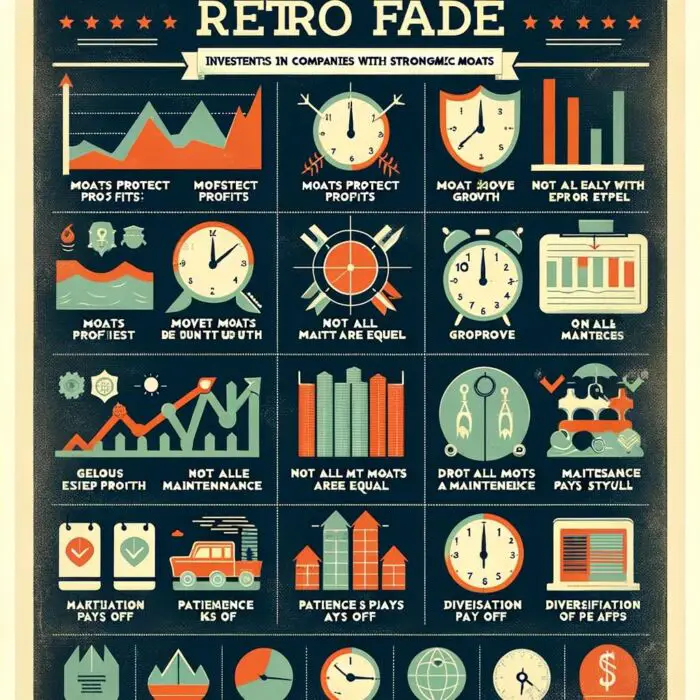
Lessons Learned from These Investments
These case studies demonstrate that investing in companies with strong economic moats can yield substantial returns over the long term. Here are some key lessons we can glean from these investments:
- Moats Protect Profits: Each of these companies has been able to maintain high profitability over the long term, largely due to their robust moats. Whether through pricing power, customer loyalty, or efficient operations, these moats have protected these companies’ profits from competitive pressures.
- Moats Enable Growth: These companies have not just maintained their profitability—they’ve also grown. Coca-Cola and Apple, for instance, have successfully entered new markets and launched new products, leveraging their moats to drive growth.
- Moats Require Maintenance: Buffett’s investments remind us that moats are not static—they need to be nurtured and defended. Coca-Cola, Apple, and See’s Candies have continued to invest in their brands, innovate, and focus on customer satisfaction to sustain and widen their moats.
- Not All Moats Are Created Equal: Each of these companies possesses a different kind of moat. Understanding the nature of a company’s moat—what creates it, how sustainable it is, how it can be widened or eroded—is crucial in investment decision-making.
- Patience Pays Off: Buffett has demonstrated remarkable patience with these investments. He bought and held these companies through various market cycles and short-term uncertainties. This reinforces the principle that investing in moat-rich companies is not about quick gains but about reaping substantial rewards over time.
- Diversification of Moats: It’s also worth noting that these companies represent different industries and have different types of moats. This underscores the importance of diversification—not just in terms of sectors or industries, but also in terms of the types of competitive advantages within an investor’s portfolio.
The wisdom that can be gleaned from Warren Buffett’s moat-focused investing style is manifold, but perhaps the most vital takeaway is this: Look for companies that possess defensible, durable competitive advantages—or economic moats—and that are run by capable, honorable management. Then buy these companies at a reasonable price and hold them for the long term. Such is the essence of the wisdom that has guided Buffett’s legendary investing career and has been illuminated in these case studies.
However, it’s also essential to remember that while economic moats can provide a company with significant advantages, they don’t guarantee success. Companies still need to navigate market dynamics, operational challenges, and a rapidly changing business environment. That’s why it’s crucial to combine a moat-focused investing approach with ongoing research and analysis. With these in hand, individual investors can improve their chances of achieving long-term investing success, just as Buffett has.
source: The Financial Review on YouTube
Challenges and Considerations in Identifying Economic Moats
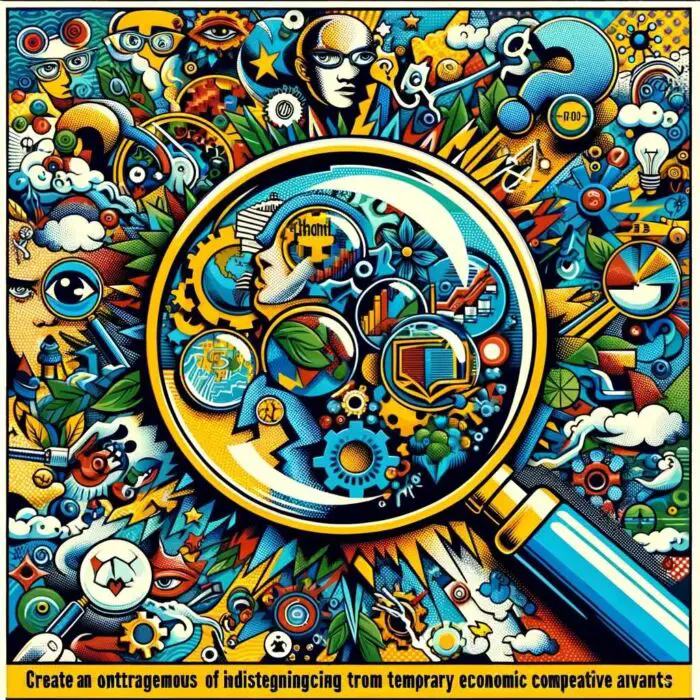
Identifying a true economic moat is more challenging than it might first appear. It’s not enough to point to a company’s current success or profitability as evidence of a moat. After all, even the most profitable company can see its competitive advantage evaporate if it’s not underpinned by a sustainable moat.
Sometimes, what appears to be a moat can turn out to be a fleeting advantage, easily replicated or surpassed by competitors. In other cases, a company’s competitive advantage might be dependent on factors outside its control, such as a favorable regulatory environment or a temporary industry trend. And at other times, a company’s success might be more attributable to a temporarily effective business strategy rather than a true, defensible economic moat.
Also, it can be challenging to distinguish between companies that have moats and those that simply operate in a currently prosperous industry. Industries with high barriers to entry or considerable regulatory oversight can seem to offer “moat-like” characteristics, but these can quickly erode if the industry dynamics change.

How Buffett Navigates These Challenges
Warren Buffett navigates these challenges through a combination of thorough research, thoughtful analysis, and, importantly, patience. He spends a significant amount of time understanding a company’s business model, industry, and competitive landscape. He reads extensively, not just company reports but also industry analysis, news, and anything else that can provide insights into a company’s moat.
One key approach Buffett uses is focusing on companies with a track record of profitability over a long period. He prefers businesses that have demonstrated their ability to generate high returns on capital consistently and grow their earnings over time.
But perhaps the most important thing that Buffett does is to apply a long-term perspective. He recognizes that while economic moats can protect a company’s profits in the short term, the real test of a moat is its ability to preserve a company’s competitive advantage over the long term.
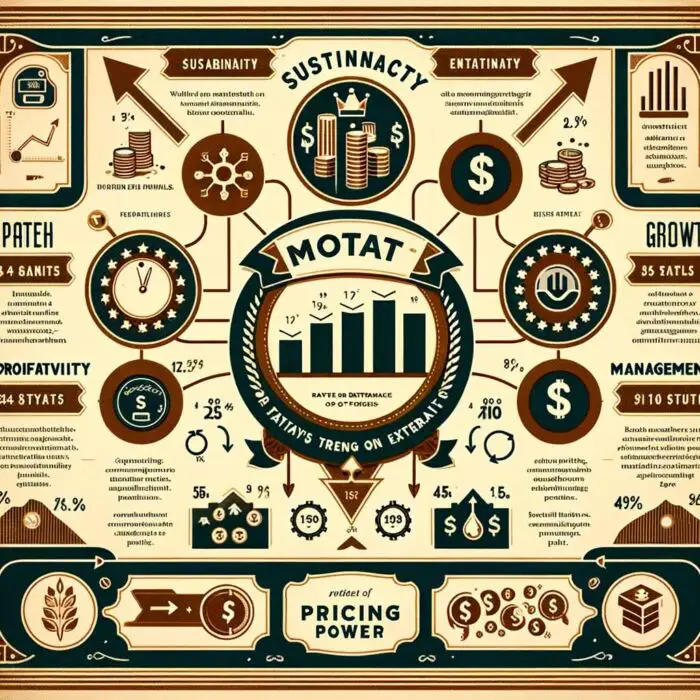
Factors to Consider When Evaluating the Strength and Durability of a Company’s Moat
When evaluating the strength and durability of a company’s moat, consider the following factors:
- Sustainability: How sustainable is the company’s competitive advantage? Can it maintain its edge over the long term? Consider whether the company’s advantage is protected by patents, copyrights, or regulatory barriers, or whether it’s easily replicable by competitors.
- Dependence on External Factors: Is the company’s success heavily dependent on factors outside its control, such as commodity prices, interest rates, or regulatory changes? If so, its moat may be less durable.
- Profitability: Does the company consistently generate high returns on capital? A strong moat should enable a company to earn more than its cost of capital over the long term.
- Growth: Can the company effectively reinvest its earnings at high rates of return? This can be a sign of a wide and deepening moat.
- Management: Does the company have a capable, committed management team that understands the importance of maintaining and expanding its moat?
- Pricing Power: Can the company raise prices without losing customers? This is often a good indication of a strong brand or high switching costs, both of which contribute to a robust moat.
Evaluating a company’s economic moat is both an art and a science. It requires a deep understanding of the company and its industry, a long-term perspective, and a healthy dose of skepticism. And, as always, it’s important to be patient. As Buffett himself has said, “The stock market is a device for transferring money from the impatient to the patient.” In the world of investing, nothing could be truer.
source: Bull Investor on YouTube
The Future of Economic Moats: Buffett’s Perspective
Economic moats, as a concept, is timeless. However, the sources of these moats and the way they manifest can and do evolve with changes in technology, consumer behavior, and the broader business environment. As the digital age unfolds, the contours of economic moats are changing. Traditional moats such as physical assets or geographical advantages are giving way to new-age moats like data dominance, digital platforms, and artificial intelligence capabilities.
Yet, while the sources of moats may be evolving, the fundamental principle remains the same: an economic moat is something that gives a company a sustainable competitive advantage. Whether that comes from a powerful brand, unique intellectual property, network effects, or cutting-edge technology doesn’t change the essential nature of the moat.
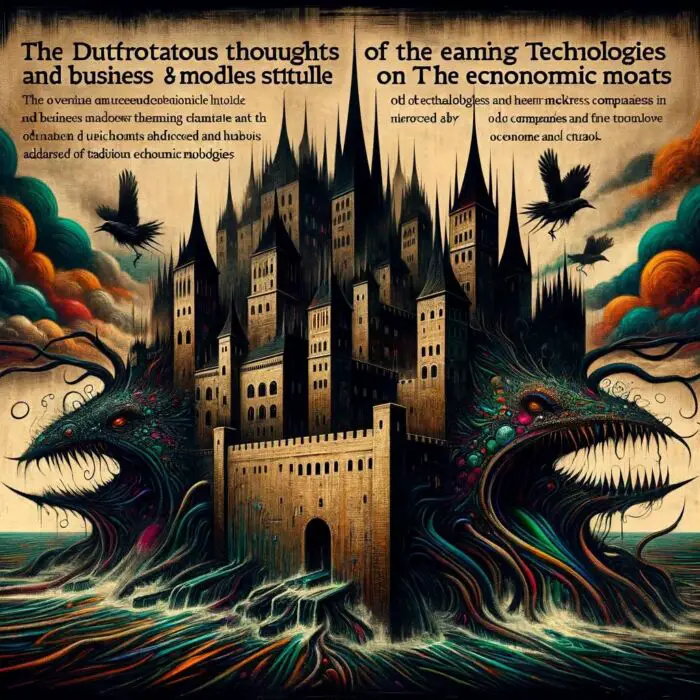
Warren Buffett’s Thoughts on Emerging Technologies and Business Models, and Their Impact on Economic Moats
Buffett, traditionally, has been cautious about investing in technology companies, not because he doesn’t appreciate the potential of technology, but because he adheres to the principle of investing in what he understands. The “Oracle of Omaha” has emphasized the difficulty of predicting which companies will establish durable moats in rapidly evolving tech sectors.
However, in recent years, Buffett has warmed up to technology investments, most notably Apple, highlighting that he values the company’s strong brand and loyal customer base – traditional moat sources – rather than its tech prowess. This demonstrates Buffett’s nuanced understanding of how technology can contribute to a company’s economic moat without fundamentally changing his investment philosophy.
How to Apply Buffett’s Wisdom in the Context of a Rapidly Changing Business Environment
In a rapidly changing business environment, Buffett’s wisdom can be applied in the following ways:
- Stick to What You Understand: Even as the sources of economic moats evolve, it remains crucial to invest in businesses you understand. If you’re not familiar with a company’s technology or its business model, it becomes much more difficult to assess the sustainability of its moat.
- Look Beyond the Hype: In an era of rapid innovation, it’s easy to get caught up in the hype around new technologies or business models. However, it’s important to distinguish between a company that has a truly defensible moat and one that simply seems innovative or trendy.
- Focus on Sustainability: Regardless of whether a company’s moat is based on traditional factors like brand strength or newer factors like data dominance, the key question remains: Is this moat sustainable? Can the company maintain its competitive advantage over the long term?
- Be Patient: Rapid changes can make the future seem more uncertain, but the principle of patience remains as relevant as ever. It can take time for a company’s true competitive strengths (or weaknesses) to become apparent.
- Continue Learning: Lastly, as the business world evolves, it’s important to continue learning and adapting your investment approach. As Buffett has said, “The most important quality for an investor is temperament, not intellect.”
Despite the evolving business landscape, the concept of economic moats remains a central tenet in Buffett’s investment philosophy. Recognizing the durability and strength of a company’s competitive advantage, irrespective of whether it’s rooted in a traditional or a more modern context, is a timeless investment wisdom that holds true in any era.

12-Question FAQ: Warren Buffett’s Views on Economic Moats — A Comprehensive Analysis
1) What does Warren Buffett mean by an “economic moat”?
A durable competitive advantage that protects a company’s profits and market share from rivals—think of a castle (the business) with a defensive moat (the advantage) that keeps returns on capital high for many years.
2) Why do moats matter so much to Buffett?
Moats make profits durable and capital compounding predictable. They lower the risk of permanent capital loss and let management reinvest cash at attractive rates over long horizons.
3) What kinds of moats does Buffett value most?
Five recurring sources:
Cost advantage (e.g., scale, low distribution costs)
Intangible assets (brand, patents, licenses)
Network effects (value rises as users join)
Switching costs (customers feel “locked in”)
Efficient scale (markets that only support a few players)
4) Can you give Buffett-style examples for each moat type?
Cost advantage: GEICO’s direct model keeps costs—and premiums—low.
Intangibles: Coca-Cola’s brand enables premium pricing worldwide.
Network effects: American Express benefits as cardholders ↔ merchants grow.
Switching costs: Enterprise IT platforms that are costly to rip out.
Efficient scale: Railroads like BNSF in capital-heavy, capacity-limited markets.
5) How does Buffett judge the durability of a moat?
He asks: Why will this edge still exist in 10–20 years? He looks for pricing power, recurring cash flows, customer captivity/loyalty, regulatory or structural barriers, and a history of high returns on capital that persist through cycles.
6) What metrics help quantify whether a moat is real?
ROIC vs. WACC (consistently and widely above)
Gross margin stability and pricing power
Retention/churn and repeat purchase rates
Unit economics improving with scale (for network/cost moats)
Free cash flow conversion and low maintenance capex needs
7) How do moats get wider—or erode—over time?
Widen: Reinforcing flywheels (brand + scale), smart reinvestment, product ecosystems, and superior service.
Erode: Technological disruption, regulation shifts, complacent management, price wars that commoditize offerings, or starved R&D/brand spend.
8) How does Buffett think about moats in tech and platforms?
He’s cautious on fast-changing tech but embraces enduring consumer moats inside tech (e.g., brand, ecosystem lock-in, network effects). The question isn’t “Is it tech?” but “Is the advantage durable and understandable?”
9) What are “pseudo-moats” investors should avoid?
Temporary advantages masquerading as moats: fad branding, short-lived patent cliffs, growth driven only by subsidies, regulatory quirks likely to change, or a hot product without switching costs or network effects.
10) When will Buffett “pay up” for a wide moat?
He prefers fair prices, but will accept a reasonable premium when the moat is exceptionally durable, reinvestment runways are long, and capital allocation is top-tier—because compounding from a great business outweighs a slightly higher entry price.
11) How should moats influence portfolio construction?
Favor a core of wide-moat, cash-generative businesses held for many years. Diversify by moat type (brand, network, cost, switching costs, efficient scale) and industry, not just by sector, to reduce common-mode disruption risk.
12) How can an individual investor apply Buffett’s moat lens?
Create a checklist:
Do I clearly understand how this firm keeps competitors out?
Evidence of pricing power and sticky customers?
ROIC > WACC across cycles?
Management integrity & capital allocation aligned with owners?
Valuation leaves a margin of safety?
If most answers are “yes,” you’re closer to a Buffett-style moat investment.
Conclusion: Buffett’s views on economic moats
Warren Buffett, the prodigious investor and sage of Omaha, has consistently demonstrated through his investment choices and teachings that economic moats are a central pillar of his investment philosophy. An economic moat, as we’ve explored, refers to a company’s sustainable competitive advantage – a defensible barrier that protects its market share and profitability against competitors.
Throughout his illustrious investing career, Buffett has favored companies exhibiting strong economic moats, such as Coca-Cola, American Express, or more recently, Apple. These companies have successfully maintained their competitive advantages due to a variety of factors – a strong brand, a vast distribution network, a loyal customer base, or even the ability to create unique, irreplicable products.
The Enduring Importance of This Concept in Buffett’s Investment Philosophy
Buffett’s success illuminates the power and importance of economic moats in investment decision-making. In his view, investing is not just about seeking out the hottest stocks or chasing the latest trends. Rather, it’s about carefully selecting companies that can defend and grow their market position over the long term, even in the face of fierce competition and changing market dynamics.
The enduring relevance of economic moats in Buffett’s philosophy is a testament to their universal applicability in investing. Regardless of changes in technology or shifts in consumer behavior, the principle remains – companies with robust economic moats are more likely to weather the inevitable storms of business cycles and generate consistent returns over the long run.

Encouragement for Investors to Utilize This Concept in Their Own Investment Decision-Making Process
Investing, at its heart, is a personal journey. It’s about developing a philosophy and a strategy that aligns with your understanding of the world, your financial goals, and your tolerance for risk. Buffett’s wisdom offers a compass for this journey – not a map to be followed step by step, but a guiding principle to help navigate the complex terrain of investment decisions.
Embracing the concept of economic moats can be an enlightening step in this journey. It encourages investors to delve deeper, look further, and think longer. It promotes a focus on fundamentals over hype, durability over novelty, and patience over immediacy. As Buffett himself once said, “Time is the friend of the wonderful company, the enemy of the mediocre.”
While the task of identifying and assessing economic moats may seem daunting, remember that investing, much like life itself, is a constant learning process. Each investment decision, each success, and each misstep offers an opportunity to learn, grow, and refine your understanding. After all, as Buffett reminds us, “The most important investment you can make is in yourself.”
So, go ahead. Immerse yourself in the world of economic moats. Explore the myriad ways companies carve out their niches and defend their territories. Learn from the wisdom of Buffett and others who have tread this path before. And as you do, may you discover not just profitable investments, but a richer understanding of the business world and your place within it.
Important Information
Comprehensive Investment Disclaimer:
All content provided on this website (including but not limited to portfolio ideas, fund analyses, investment strategies, commentary on market conditions, and discussions regarding leverage) is strictly for educational, informational, and illustrative purposes only. The information does not constitute financial, investment, tax, accounting, or legal advice. Opinions, strategies, and ideas presented herein represent personal perspectives, are based on independent research and publicly available information, and do not necessarily reflect the views or official positions of any third-party organizations, institutions, or affiliates.
Investing in financial markets inherently carries substantial risks, including but not limited to market volatility, economic uncertainties, geopolitical developments, and liquidity risks. You must be fully aware that there is always the potential for partial or total loss of your principal investment. Additionally, the use of leverage or leveraged financial products significantly increases risk exposure by amplifying both potential gains and potential losses, and thus is not appropriate or advisable for all investors. Using leverage may result in losing more than your initial invested capital, incurring margin calls, experiencing substantial interest costs, or suffering severe financial distress.
Past performance indicators, including historical data, backtesting results, and hypothetical scenarios, should never be viewed as guarantees or reliable predictions of future performance. Any examples provided are purely hypothetical and intended only for illustration purposes. Performance benchmarks, such as market indexes mentioned on this site, are theoretical and are not directly investable. While diligent efforts are made to provide accurate and current information, “Picture Perfect Portfolios” does not warrant, represent, or guarantee the accuracy, completeness, or timeliness of any information provided. Errors, inaccuracies, or outdated information may exist.
Users of this website are strongly encouraged to independently verify all information, conduct comprehensive research and due diligence, and engage with qualified financial, investment, tax, or legal professionals before making any investment or financial decisions. The responsibility for making informed investment decisions rests entirely with the individual. “Picture Perfect Portfolios” explicitly disclaims all liability for any direct, indirect, incidental, special, consequential, or other losses or damages incurred, financial or otherwise, arising out of reliance upon, or use of, any content or information presented on this website.
By accessing, reading, and utilizing the content on this website, you expressly acknowledge, understand, accept, and agree to abide by these terms and conditions. Please consult the full and detailed disclaimer available elsewhere on this website for further clarification and additional important disclosures. Read the complete disclaimer here.



